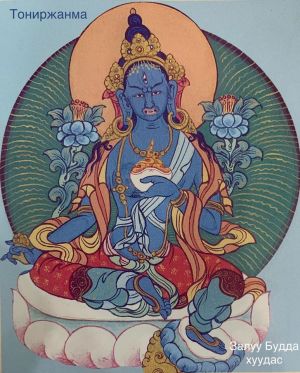Dakini in Shaivism
Ḍākinī (डामरी):—Name of one of the eight female deities (yoginīs) of the Yoginīcakra, according to tantric sources such as the Śrīmatottara-tantra and the Gorakṣa-saṃhita. In other tantric sources, such as the kubjikāmata-tantra, she is identified as Ḍāmarī. She is also mentioned as a similarly positioned yoginī in the Kulārṇava-tantra and the Ṣaṭcakranirūpaṇa where she forms part of a group of six or seven such female deities. The male counterpart of Ḍākinī is the Bhairava named Asitāṅga, who should be visualized mentally.
Ḍākinī (and the other eight yoginīs) arise forth from the body of the Bhairava named Saṃvarta, who is described as a furious deity (mahāraudra) with various fearsome characteristics. During worship, She is to be placed in a petal facing east. Ḍākinī has the head of a cat (biḍāla) according to the Śrīmatottara-tantra, or the head of a serpent (sarpa) according to the Kulārṇava-tantra. She has eight arms and holds in her right hands a trident, a knife, a sword and the fearful serpent-king. In her left hands she makes the gesture of reassurance (abhaya) with one hand and holds a shield, a noose and a spear in the other hands. She also wears ear-rings and a neckalce of bones (asthi). Her colour is dark-blue (nīla).
Shaiva (शैव, śaiva) or Shaivism (śaivism) represents a tradition of Hinduism worshiping Shiva as the supreme being. Closely related to Shaktism, Shaiva literature includes a range of scriptures, including Tantras, while the root of this tradition may be traced back to the ancient Vedas.
Purana and Itihasa (epic history)
Dakini in Purana glossary... «
Ḍākini (डाकिनि).—A class of women supposed to be proficient in magic and the performance of feats with the help of mantras. (See Kṣuraka).
Source: archive.org: Puranic Encyclopaedia 1) Ḍākini (डाकिनि).—An attendant on Śiva.*
2) Ḍākinī (डाकिनी).—A Śakti on the fourth parva of Kiricakra.*
3) Dākini (दाकिनि).—Evil spirits injuring children.*
Tibetan Buddhism (Vajrayana or tantric Buddhism)
Dakini in Tibetan Buddhism glossary... « previous · [D] · next » In the Tibetan language, dakini is rendered Khandroma which means she who traverses the sky or she who moves in space. Sometimes the term is translated poetically as sky dancer or sky walker. The dakini, in all her varied forms, is an important figure in Tibetan Buddhism. She is so central to the requirements for a practitioner to attain full enlightenment as a Buddha that she appears in a tantric formulation of the Buddhist Three Jewels refuge formula known as the Three Roots.
The dakini, in her various guises, serves as each of the Three Roots. She may be a human guru, a vajra master who transmits the Vajrayana teachings to her disciples and joins them in samaya commitments. The wisdom dakini may be a yidam, a meditational deity; female deity yogas such as Vajrayogini are common in Tibetan Buddhism. Or she may be a protector; the wisdom dakinis have special power and responsibility to protect the integrity of oral transmissions
Ḍākinī (डाकिनी, “lion-faced”) is the name of the goddess found on the eastern petal of the vārāhyabhyudaya-maṇḍala, according to the Vārāhyabhyudayatantra. The central deity of the vārāhyabhyudaya-maṇḍala is the twelve-armed Vajravarāhī, which is modeled upon the twelve-armed Cakrasaṃvara, thus inhibiting many similar iconographical features.
Ḍākinī is to be visualised by the practitioner as a fierce and therianthropic (half-beast, half-human) goddess having three eyes, loose hair and dancing naked in the ardhaparyaṅka pose, with Bhairava and Kālarāri beneath their feet. They are depicted as having four arms, holding a skull and staff in two arms while holding the head of Brahmā and a chopper in the other two arms.
The Vārāhyabhyudayatantra is an explanatory tantra on the Laghuśaṃvara, but its verses are largerly extracted from the 10th century Abhidhānottaratantra, a scriputre describing various sādhanas (path towards spiritual realization).
In tantric Buddhism.a ḍākinī is a type of accomplished yoginī or else a female deity, depicted iconographically as a naked semi-wrathful figure who acts as a guiding intermediary for practitioners and assists in the actualization of siddhis. First noted in Indian sources around the 4th century ce, ḍākinīs were probably tribal shamanesses in origin and their name can be linked to cognate terms meaning ‘summoning’ and ‘drumming’ rather than ‘flying’ as suggested by the Tibetan translation which means ‘sky-goer’.
Source: Oxford Reference: A Dictionary of Buddhism
ḍākinī (डाकिनी).—f S pop. ḍāṅkīṇa, ḍākiṇī, ḍāṅkhīṇa f See ḍaṅkhīṇa.
Source: DDSA: The Molesworth Marathi and English Dictionary ḍākinī (डाकिनी).—f ḍāṅkīṇa, ḍākiṇī, ḍāṅkhīṇa f See ḍaṅkhīṇa.
Ḍākinī (डाकिनी).—A kind of female imp, a female goblin; Bhāg.1.63.1.
Source: DDSA: The practical Sanskrit-English dictionary Ḍākinī (डाकिनी).—f. (-nī) A kind of female imp or evil being. ḍākānāṃ samūhaḥ ini
